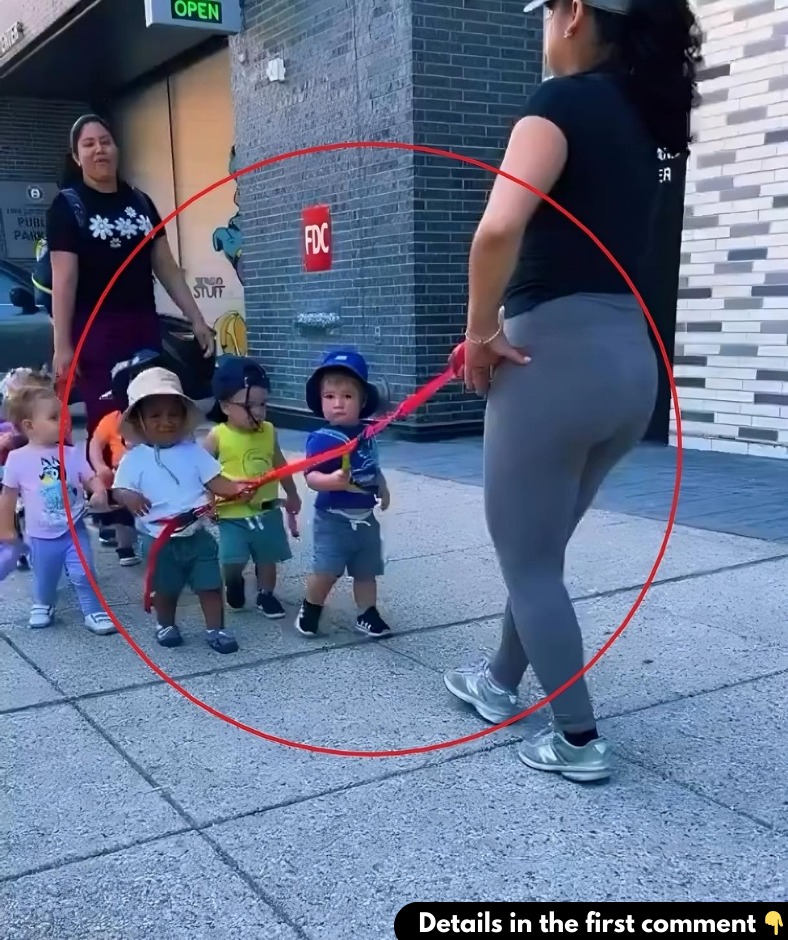A recent video has stirred up heated debate, showing a teacher leading children on a walk with a controversial twist: the kids are tied together to prevent them from getting lost. The caption of the video reads, “Their teacher took them for a walk and tied them up so they wouldn’t get lost.” This has sparked serious ethical questions: Is tying children together a reasonable safety measure, or does it cross the line into an extreme and unnecessary action?

Understanding the Teacher’s Intention
Initially, the teacher’s intention to ensure the safety of young children seems valid. When supervising a group of children outdoors, especially in crowded or unfamiliar areas, keeping everyone together is essential. The teacher likely viewed tying the children as a practical way to maintain group integrity, making sure no child wandered off.
However, while the aim of keeping the children safe is understandable, the method—physically tying the children together—immediately raises concerns. Safety is crucial, but it must be balanced with respect for the children’s autonomy, dignity, and comfort. This balance is at the heart of the controversy surrounding this decision.
The Question of Safety Versus Comfort
Safety is always a top priority in educational settings, and teachers have a duty to protect their students from harm. This responsibility becomes even more pressing when children are outside of school grounds, where the risk of a child getting lost increases. Given this, it’s understandable that the teacher sought a reliable way to keep the group intact.
However, tying children together introduces physical restraint, which can be perceived as discomforting or even degrading. Children need to feel safe, but they also need to feel respected and trusted. Using ropes to keep them together may come across as treating them more like objects to control than individuals to care for.
There are alternative methods to ensure safety that avoid physical restraint. For instance, child-friendly walking ropes allow children to hold onto a shared rope while walking, keeping the group together without making them feel restricted. Assigning group leaders or having the children hold hands in smaller groups are other methods that encourage safety while respecting autonomy.
Potential Psychological Effects
Beyond the physical aspect, there are psychological effects to consider. Even if the intent is purely for safety, being tied together could make children feel embarrassed, scared, or humiliated. For young children still developing independence, such an experience could erode trust in their teacher.
Children may not fully grasp why they are being tied together, which could lead to feelings of helplessness or a sense of powerlessness, potentially causing anxiety. Even when safety is the top priority, educators should aim to create a sense of security without compromising emotional well-being. Actions that cause discomfort or distress can leave lasting negative impressions and potentially harm a child’s trust in authority.
Legal and Ethical Considerations
Legally, physically restraining children in schools is a delicate matter. In many regions, there are strict guidelines about how teachers can physically interact with students, especially when it comes to restraint. Tying children together could be seen as crossing this line, leading to potential legal issues or violations of school policies.
Ethically, teachers are expected to uphold high standards of care, safeguarding students’ physical and emotional well-being. Even when intended to protect, methods like physical restraint can be controversial, often viewed as inappropriate or abusive. This raises significant concerns among parents, educators, and administrators, making it a topic that requires critical reflection.
Is It a Matter of Overreach?
The central question is whether tying the students together was necessary or an overreach. While the teacher’s main concern was safety, the approach appears to have crossed an ethical line. Even when temporary, tying children together conveys a sense of control that clashes with the values of trust and respect that educators should nurture.
Safer alternatives exist that maintain dignity, such as child-friendly ropes, visual group leaders, or holding hands in pairs. These methods promote safety without introducing ethical or psychological issues. Teachers should prioritize solutions that are both safe and respectful.
Reevaluating Safety Practices in Education
This incident sheds light on broader issues regarding safety measures in schools. Teachers often grapple with balancing protection with fostering independence, trust, and respect. It’s crucial to approach safety holistically, considering not just physical risks but also emotional and psychological impacts.
The method used in the video should prompt educators and policymakers to reconsider what constitutes appropriate safety measures for children. Ensuring safety shouldn’t come at the cost of children’s comfort or sense of agency.
Conclusion: Balancing Safety and Respect
The video of the teacher tying students together has sparked a debate about the extent to which educators should go in the name of safety. While the teacher’s intention was clearly to protect students, the method raises ethical concerns about how children are treated in schools.
Striking a balance between safety and respect for children’s rights is essential. Teachers must be creative and mindful in choosing methods that protect students without causing unnecessary discomfort. By adopting solutions that are effective yet humane, educators can create environments where safety and respect coexist.
The ultimate goal should be to create a safe, trusting, and respectful learning environment, using methods that uphold both children’s well-being and their sense of autonomy.





